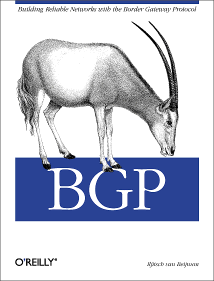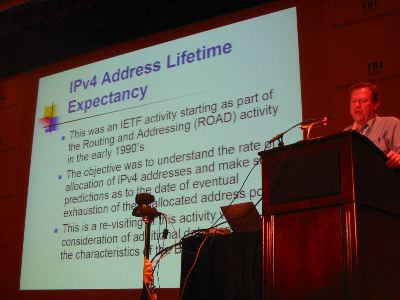
|

|

|
|
Home ·
BGP Expert Test ·
What is BGP? ·
BGP Vendors ·
Links ·
Archives ·
Books ·
My New BGP Book | ||
 (advertisement)
(advertisement)
| ||
|
IPv4 Address Lifetime Expectancy Revisited (posted 2003-09-16)
At the end of the thursday plenary at the RIPE 46 meeting, Geoff Huston presented IPv4 Address Lifetime Expectancy Revisited (PDF).
 If looking at the slides leaves you puzzled, have a look at one of Geoff's columns from a few months ago that (as always) explains everything both in great detail and perfect clarity: IPv4 - How long have we got? (The full archive is available at http://www.potaroo.net/papers.html.) Geoff looks at three steps in the address usage process:
It looks like the free IANA space is going to run out in 2019. But the RIRs hold a lot of address space in pools of their own, if we include this the critical date becomes 2026. Initially, projections of BGP announcements would indicate that all the regularly available address space would be announced in 2027, and if we include the class E (240.0.0.0 and higher) address space a year later. However, Geoff didn't stop there. After massaging the data, his conclusion was that the growth in BGP announcements doesn't seem exponential after all, but linear. With the surprising result:
"Re-introducing the held unannounced space into the routing system over the coming years would extend this point by a further decade, prolonging the useable lifetime of the unallocated draw pool until 2038 - 2045." Now of course there are lots of disclaimers: whatever happened in the past isn't guaranteed to happen in the future, that kind of thing. This goes double for the BGP data, as this extrapolation is only based on three years of data. But still, many people were pretty shocked. It was a good thing this was the last presentation of the day, because there were soon lines at the microphones. So what gives? Ten years ago the projections indicated that the IPv4 address space would be depleted by 2005. Now, an internet boom and large scale adoption of always-on internet access later, it isn't going to be another couple of years, but four decades? Seems unlikely. Obviously CIDR, VLSM, NAT and ethernet switching that allows much larger subnets have all slowed down address consumption. But I think there are some other factors that have been overlooked so far. One of those is that some of the old assignments (such as entire class A networks) are being used up right now. For instance, AT&T Worldnet holds 12.0.0.0/8, but essentially this space is used much like a RIR block, ranges are further assigned to end-users. We're probably also seeing big blocks of address space disappearing from the global routing table because announcing such a block invites too much worm scanning traffic. On the other hand there are also reports from "ISPs" that assign private address space to their customers and use NAT. So I guess there is a margin of error in both directions. The the same time, the argument can be made that for all intents and purposes the IPv4 address space has already run out: it's way too hard to get the address space you need (let alone want). This is in line with what Alain Durand and Christian Huitema explain in RFC 3194. They argue that the logarithm of the number of actually used addresses divided by the logarithm of the number of usable addresses (the HD ratio) represents a pain level: below a ratio of 80% there is little or no pain, trouble starts at 85% and 87% represents a practical maximum. For IPv4 that would be 211 million addresses used (note that in the RFC the number is 240 million, but this is based on the full 32 bits while a little over an eighth of that isn't usable). According to the latest Internet Domain Survey we're now at 171 million. This is counting the number of hosts that have a name in the reverse DNS, so the real number is probably higher. I think RFC 3194 is on the right track but rather than simply do a log over the size of the address space, what we should look at is the number and flexibility of aggregation boundaries. In the RFC phone numbers are cited. Those have one aggregation boundary: area code vs local number, with a factor 10 flexibility. This means wasting a factor 10 (worst case) once. Classful IPv4 also had a single boundary, but the jumps are 8 bits, so a waste of a factor 256. With classless IPv4 we have more boundaries, but they're only one bit most of the time: IANA->RIRs, RIR->ISPs, ISP->customers and subnet. That's four times a factor two, so a factor 16 in total. That means we can use 3.7 billion addresses / 16 = 231 million IPv4 addresses without pain. Hm... But we can collapse some boundaries to achieve better utilization.
|
